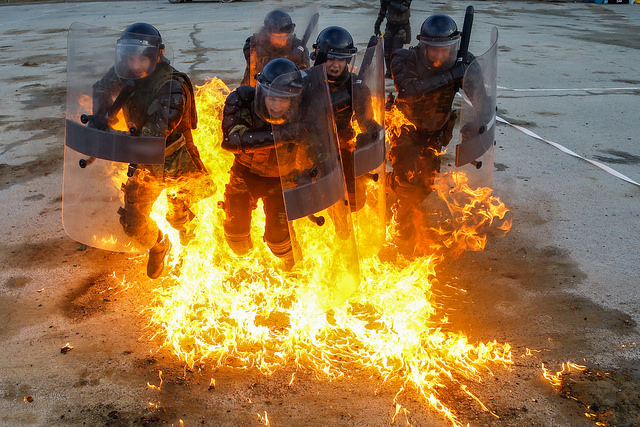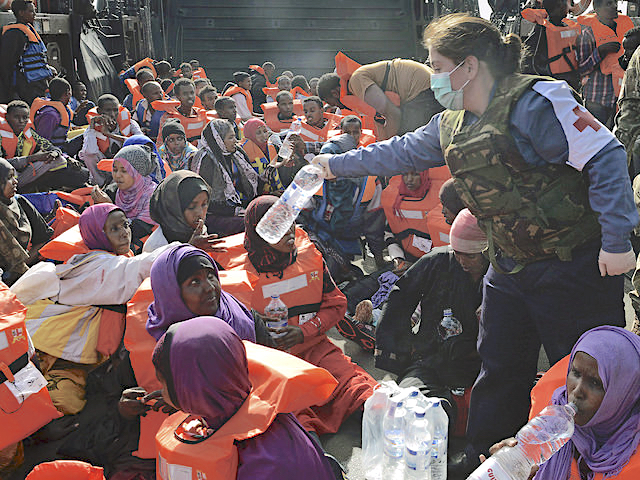It’s normal to hear NATO described as an “internationalist project” in Western Europe. Even the centre-left has long stood by the Atlantic alliance. Britain was signed up to NATO by the post-war Labour government. By contrast, France withdrew from NATO under the leadership of Charles de Gaulle as part of his politics of grandeur. Yet the NATO project may not have been so lost in the Cold War as it is today.
Founded in 1949, NATO was devised ostensibly to secure Western Europe from the Soviet Union and its Eastern satellite-states. The Warsaw Pact emerged in direct response to NATO. But there would be no engagements or altercations despite a lot of hot air. It wouldn’t be until September 2001 – long after the demise of the Eastern bloc – that NATO would take action. Article Five was called in following the attacks on the World Trade Centre, and NATO forces would bomb Afghanistan.
If we rewind for a moment, we find the end of the Cold War brought talk of peace dividends after a bloody century. Without the nuclear stand-off, the role of NATO was suddenly worth questioning. The North Atlantic Treaty held its own as the Warsaw Pact collapsed, and the peace movement would be vindicated. The truth was practically admitted, NATO was never about defence. It was about offence and hegemony.
Not only did the US have no intention of dismantling NATO, the project would expand to include a reunited Germany. Expansion would continue eastwards in years to come. However, NATO had a major problem, it had lost its only pretext. The first such opportunity would come in the Balkans, where Yugoslavia was imploding. Later, there would be new opportunities in Afghanistan and Libya. Therefore, it’s worth taking a critical look at these campaigns.
Saving NATO
The NATO bombing of Yugoslavia is often touted as a humanitarian success story. The truth is always less rosy. There are serious misconceptions about the conflict, particularly the Kosovan phase of the Balkan wars. Serbia is often painted as the key aggressor in the regional conflict. Although this is not entirely inaccurate, the full picture of competing nationalist claims is lost here.
It’s often talked about as if the NATO bombing campaign stopped a genocide in Kosovo. The West may have opposed Serbian aggression, but it fully supported the efforts of Kosovar Albanian nationalists fighting for a Greater Albania. In fact, the CIA armed and trained the Kosovo Liberation Army (KLA) for its insurgency against Serbia. NATO even installed war criminal Agim Ceku as KLA leader.
Ethnic cleansing was committed by all sides in the Balkan wars. Of course, the leading aggressors were Serbia and Croatia, as they had more guns than anyone else. In the case of Bosnia, the state was left considerably weaker, though it did fall back on US support. Croatia and Serbia backed proxies to try and tear apart the US client-state. This led to the Republic of Srpska and the notorious crimes of Radovan Karadzic and Ratko Mladic.
The horror of the Srebrenica massacre drew understandable calls for the West to “do something”. Well, the first NATO bombing campaign may have hastened the military stalemate, which allowed for the Dayton Accords. But the agreement led to the partition of the country. It effectively validated the concerns of ethnic Croatian and Serbian nationalists in Bosnia. The Office of the High Representative of the UN was set up to guarantee the new settlement.
By contrast, the second NATO campaign in 1999 was predicated on claims that the Serbs were killing ethnic Albanians as part of a genocide. There was certainly ethnic cleansing being waged by both sides, but there is also evidence that the bombing precipitated far worse atrocities. Again, the US was fighting on the side of its clients and not acting out of humanitarian motives. Kosovo was worthy of defence because it could be used to secure NATO’s prestige.
Contrary to popular wisdom, the US was quick to take sides in the Yugoslav wars, first with the secessions of Slovenia and Croatia, secondly on the side of the Bosnian government in 1995, and lastly with the KLA against Serbia. Meanwhile Croatia was supported by Germany, just as Serbia fell back on Russian support. This was the violent apogee of of a long process.
Tito‘s Yugoslavia was built as a market socialist economy. The idea was to allow a space for private property and market forces within state constraints, which included a great deal of state planning and workers’ self-management. At the same time, Tito pursued a non-aligned foreign policy and ‘brotherhood and unity‘ at home – setting out to block the return of ethnic chauvinism.
As part of this federal approach, Kosovo and Vojvodina were granted autonomy to dilute the power of Serbia and allow greater space for other republics. This was supposed to guarantee peace and stability for the future. However, the balance of forces in Yugoslavia was underpinned by its economic strength. Once this was gone, the doors of secession and war were open.
https://www.youtube.com/watch?v=M_PzsfXbyAw
Hocked up with debt from the 1973 energy crisis, the Yugoslav leadership initiated economic reforms to repay the debt. This led to greater economic stagnation and competition for resources between the republics. As a result, the idea of a multicultural confederation began to break down and nationalism re-emerged. A major turning point was when Milosevic sided with ethnic Serbs in tensions with Albanians in Kosovo.
By the early 1990s, Yugoslavia was facing an existential crisis. Nationalism came back with a vengeance, as new forces struggled over resources and power. Tito’s dream of a socialist confederation was rapidly decomposing. At this point, the US government made clear it would provide aid to secessionist republics. The two wealthiest republics Croatia and Slovenia soon declared independence.
In the years that followed the Clinton administration took US policy to its ultimate conclusion. Before Clinton, George HW Bush cut off aid to Yugoslavia, except to any secessionist republics. Reagan created the National Endowment for Democracy to funnel support to right-wing elements inside Yugoslavia. This combined with the return of nationalism helped bring about the death of a country. But this was business as usual.
Imperial decline
Not long after the bombing of Serbia, NATO would be redeployed and this time it would be in Afghanistan. Faced with September 11th, the Bush administration found itself with a pretext for war. Of course, the American establishment had wanted to invade Iraq for a long time, but the immediate target was Afghanistan. The Taliban regime would be held responsible for al-Qaeda given that Osama bin Laden was living in the country at the time.
Although the Taliban offered to extradite bin Laden, the US began bombing the country. It was the first time NATO was deployed to defend one of its members. Officially, the US war aim was to capture the al-Qaeda figurehead. When it became apparent that Osama had already fled, the purpose of the mission shifted to regime change and occupation. Once again, NATO was a framework for American unilateralism.
“Well, look, we act as we see fit, when we see fit, through whatever organisation we can,” George W Bush later said. “We try the United Nations Security Council, if it approves we go under the flag of the United Nations. If it doesn’t, we use NATO. If there are differences within NATO, as there were in Iraq, we go it alone.”
France, Germany, Russia and China were not happy to back the US in Iraq. This was not the case on Afghanistan. Many liberals were happy with the US case for war, as al-Qaeda had struck first and created an apocalyptic scene in New York City. Like the Soviet invasion of 1979, the US framed its occupation of Afghanistan as a civilising mission. This humanitarian rhetoric was convenient for the centre-left to swallow.
Of course, the reality of the occupation is quite different. Afghanistan was not important in itself for outside powers. Rather Afghanistan may be seen as the battleground between different regional and international powers. The country is vital for a future Central Asian energy network. A client regime in Kabul is handy for anyone looking to build natural gas pipelines. It’s also a major concern for both Pakistan and India, as the Kashmir conflict is still ongoing.
A questionmark had been hanging over Afghanistan since the Taliban came to power in 1996. Years of fighting by warlords was brought to an end. Former CIA asset Hekmatyar was chased out of Kabul. The Taliban set out to replace chaos with its own version of harsh Islamic rule. By 2001, the US had enough cause to go in with NATO, but this was no humanitarian intervention. The US invasion meant the return of the warlords and a new government in Kabul.
Fifteen years later Afghanistan is still occupied by American forces. NATO was meant to withdraw in 2014, instead it has scaled back its presence. The Ghani government has just cut a new deal with Hekmatyar, while the Taliban remains a potent threat. It is unclear when the US will leave Afghanistan, but the failure of the mission is almost certaint. They call Afghanistan the graveyard of empires for a reason.
Revolutionary upheaval
After the Bush years, the Obama administration searched for stability on US terms. The deals cut with Iran and Cuba represent the best of this newfound realism. However, the search for stability led Obama to opt for continuity in Afghanistan. It is not possible for the American government to admit failure, and so the withdrawal is being offset for an unknown date.
This is not to say the Obama doctrine, if there is such a thing, has a uniform approach. When the Arab Awakening led to the Libyan civil war, Obama was reluctant to move first and found France and Britain were much more eager for regime change. This was not to bring democracy to the country, but to ensure the West had a stake in the outcome.
Always the pragmatist, Obama went in for the UN no-fly zone. This provided adequate legal cover for a NATO air campaign. Although the UN mandate was clear, the NATO intervention would depart from it to ensure rebel victory. By this point, the West had decided to do away with Colonel Gaddafi and his mercurial regime. The Libyan rebels promised to respect old oil arrangements. This pledge was enough.
There was a rush to sign off on oil contracts as the rebels won. David Cameron and Nicolas Sarkozy came to Tripoli to celebrate the rebel victory. The fact that the country was lacking institutions and organisations capable of building a new Libya was lost in all of this. It was a neoliberal war. There would be no Marshall Plan and no reconstruction. Consequently, Libya is now mired in a war of all against all and a second intervention might be on the cards.
Obama now says he regards Libya as his “worst mistake“. He has made it clear he saw it as a European responsibility to ensure stability in the North African country. After all, the power vacuum created the space for refugees to reach Italy’s shores. It’s clear why the West wants to contain the crisis in Libya, and once again humanitarian motives are absent. This is the world we live in.
Photographs courtesy of 7th Army Training Command. Published under a Creative Commons license.





